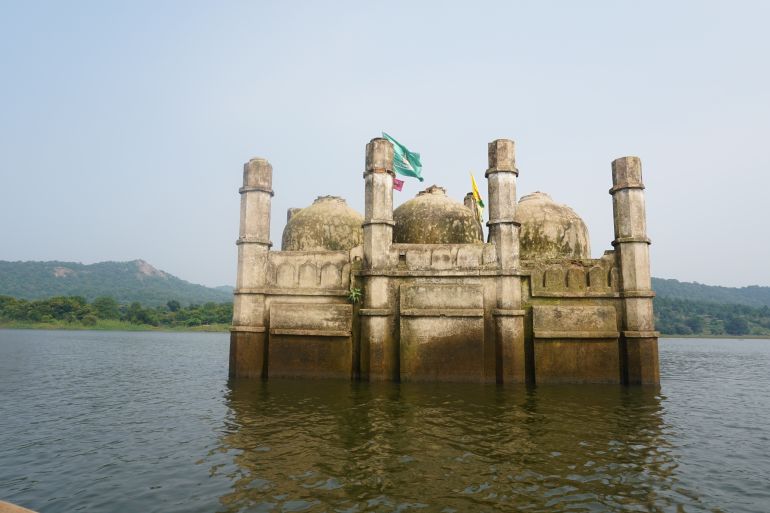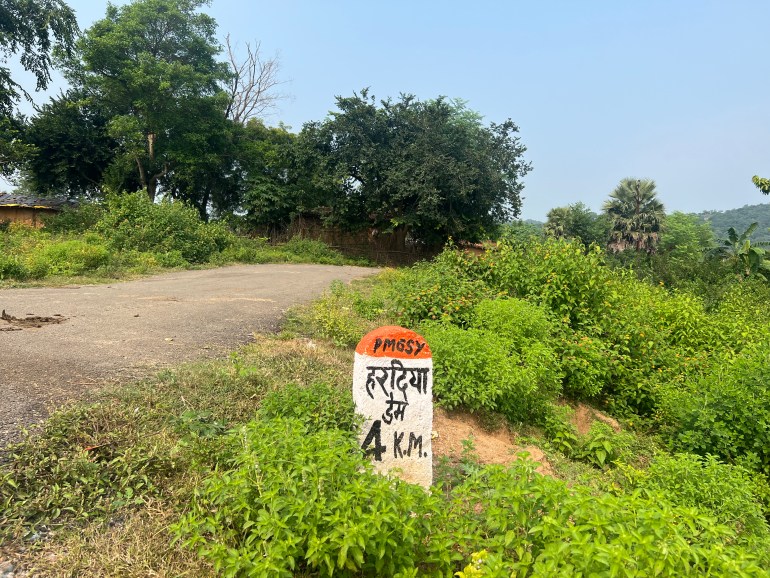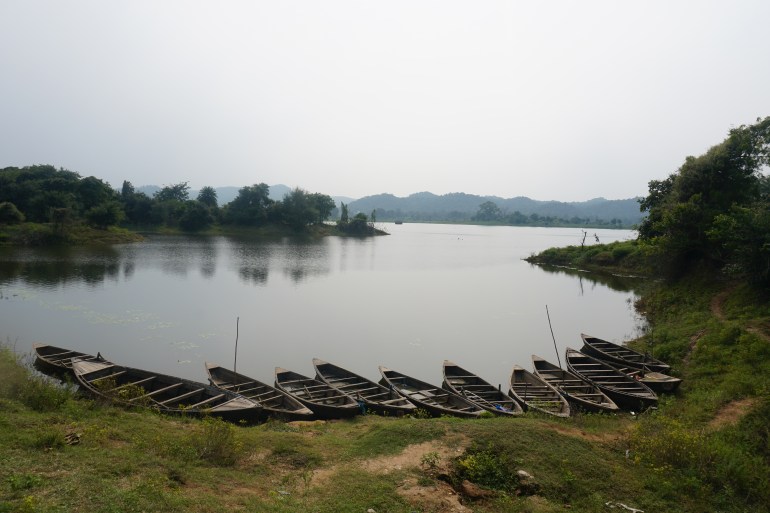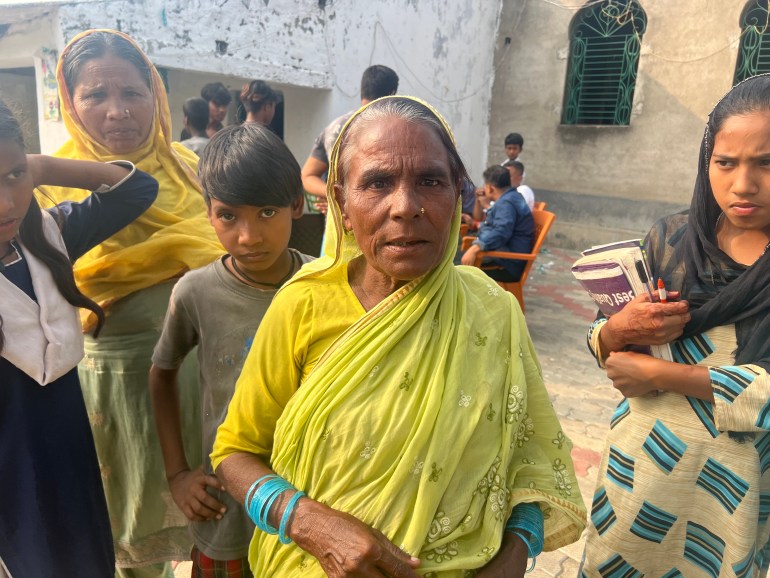‘We lived there once’: An underwater mosque resurfaces in India
As tourists flock to visit the novel site, a mosque’s reappearance reminds villages nearby of displacement and a growing water crisis.

As the climate crisis causes water levels to plummet, riverbeds to dry and glaciers to melt, artefacts like old warships, an ancient city and human remains have emerged. This story is part of “Climate artefacts”, a miniseries telling the stories behind the people, places and objects that have been discovered due to drought and warming temperatures.
Nawada district, Bihar, India – As a child, Muhammad Aftab Hussain would go to the cream-coloured mosque near his house to pray and study. When the mosque was empty, Hussain and other children from his village in Bihar, a state in eastern India, would shout in the domed structure and listen to their voices reverberate.
Keep reading
list of 4 itemsEgypt demands return of ancient Rosetta Stone
Europe’s drought exposes WWII ships, bombs and prehistoric stones
Peru: Archaeologists say unearthed mummy could be 1,200 years old
“This would give me joy when the voice would echo back. Every child used to repeat that. It was fun,” 50-year-old Hussain recalled.
But, 34 years ago, during the construction of a dam, the mosque, called Noori Masjid, disappeared underwater along with Hussain’s childhood village of Chiraila.
In early September this year, after high temperatures and a lack of rainfall caused water levels to fall, the entire mosque surfaced for the first time since it was inundated. Curious tourists were drawn to the site at Phulwaria Dam, some five hours’ drive south of the state capital Patna.
“The mosque was there – we knew it. It was completely flooded after the dam was constructed,” said Hussain, speaking in the nearby village of Hardiya where he moved as a teenager when his village was engulfed by water.
According to climate experts, the mosque’s reappearance points to severe drought conditions in one of India’s poorest states. For Hussain, the event has opened up memories of displacement. He and the other residents of Chiraila along with those of dozens of villages on either side of a stream in a low-lying area were forced to leave their homes in the 1980s.
“The mosque has become a point of attention for people but it also reminds us about life back in the village,” said Hussain.

‘No one would go hungry’
Chiraila was a quiet village where Muslims and Hindus lived side by side. Some villagers owned land while others made a living by farming it, cultivating mostly maize and rice paddy, recalled Hussain. Chiraila was surrounded by low mountains and at the stream nearby, people would fetch water and perform ablution before prayers.
“It was like Kashmir,” he said with pride, referring to the picturesque Himalayan region located in northern India.
Muhammad Hanief, 65, another former resident of Chiraila, sat outside a white, partially built mosque in Hardiya, where he also lived. The structure rises above the village’s small, two-room houses.
“People were able to earn and eat, as well. That was the speciality of the village. No one would go hungry. People did not care about your religion,” said Hanief, referring to the interfaith tension seen in parts of India in recent years.
Chiraila consisted mostly of mud huts with thatched roofs but the small mosque at the centre of the village stood apart with its plastered surface, which was cool in the summer, cemented courtyard and arched gates.
Former Chiraila residents believed the structure to be more than 100 years old.
“The mosque was there when I was born. It was there even when my father was born,” said Hanief, who has a soft voice and a flowing white beard.
“The masons who designed it knew the work of ‘surkhi chuna’ [made from burned ground bricks mixed with lime mortar to use in construction] to make them [structures] resilient, and last long. It was hard work and required special skill,” said Hussain, who works as a daily wage labourer including on building sites.
Although Hussain and others believed the mosque was built after the rule of the Mughals, the Muslim dynasty that ruled from the 16th to 19th century, its three domes, eight minarets and archways recall the buildings constructed across India during the dynasty.

‘We had resisted’
In 1985, the residents of Chiraila and those of more than two dozen villages were forced to move to Hardiya, seven kilometres (four miles) from their village.
“Nobody wanted to leave. We had resisted. But we were forced within a month to leave and threatened by authorities that we will submerge in floods if we do not relocate,” recalled Hussain with anger in his voice.
Chiraila was demolished but the mosque was left untouched because it was a holy site, former villagers said.
Standing outside his cement and brick house in Hardiya, Hussain said since all the former residents of the flooded village now live in the same place and remain a close-knit community, they named their new neighbourhood, Chiraila.
They also named the unfinished mosque, which they started constructing after moving to Hardiya, Noori Masjid, in tribute to the original place of worship. “Because everyone is poor here, we are doing things bit by bit with small donations,” said Hussain of the construction.
In Hardiya, now home to about 7,000 people, they had to rebuild their lives from scratch, Hussain said. The land provided was enough to build new homes, but not to cultivate crops. Villagers struggled to find new livelihoods and many became labourers.
“The government provided us a patch of land and deserted us,” said Hanief as several of his neighbours gathered around him.
“No one is happy here. People miss the old village,” said Hussain.

‘Not a miracle’
When the mosque first emerged, residents said hundreds of visitors came to admire the unusual sight. Tourists waded through mud to enter the building and inspect the architecture. Some visitors attempted to clean it. At least one gave the call to prayer outside it. Although the initial numbers have thinned, visitors still come.
Since it completely emerged in September, rain has caused the water level to rise by at least two metres (seven feet), enveloping part of the structure once again.
After remaining underwater for so long, the mosque’s plaster surface has peeled in many places and is covered by algae. The minarets on the corners and roof have cracks. As one draws closer, a musty smell wafts from the building.
On a sunny afternoon in early October, 12 wooden boats tethered to the shore bobbed in the water. Fishers living nearby waited for visitors to row them to the mosque which is about one kilometre away by boat.
“We came to see it because this is a historical marvel. We saw a video on YouTube and we were amazed and wanted to see if it exists for real,” says 42-year-old Nitesh Kumar, a software engineer, who was visiting with four friends from a district 70km (43 miles) away.
Hussain has not visited the mosque since it reappeared. But he has seen the YouTube videos of what tourists consider to be a novelty. “This mosque is not a miracle for us,” he said.
“I have been working around the dam as a fisherman for decades. It is for the first time in 30 years that I am witnessing it is fully visible,” said Goraylal Singh, 51, who also works as a farmer and lives on Phulwaria’s shores.
“The mosque has added an extra earning for me. Apart from fishing, I take tourists for a boat ride to the site,” he said.

A sign of water shortages
In the past, the mosque’s domes would surface when the water levels dropped. For farmers in the area, whose agriculture depends on rainfall, the mosque’s reappearance is a sign of the hardship that one of India’s largest, rice-producing states is facing due to erratic and scant rainfall.
“It shows that there is not enough water. So, it is not a good thing for the farmers whose lives are dependent on it,” Sahdev Yadav, a 45-year-old paddy farmer, explained.
For climate experts, Noori Masjid’s reappearance was linked to climate change-induced drought. Usually, 84 percent of the state’s rainfall occurs during four months, from June to September, during the monsoon season.
“In July, there were extremely dry conditions which is the time for sowing rice. This was unprecedented,” Abdus Sattar, a scientist at the Centre for Advanced Studies on Climate Change at Rajendra Prasad Central Agricultural University in Bihar, told Al Jazeera.
Nawada was one of 11 of Bihar’s 38 districts considered “drought-hit”, while official figures show that the state received 39 percent less rainfall than normal this year. This has been a major setback for people in the state, where half the population lives below the poverty line.
Sattar said the low levels in the dam, which was mainly built for irrigation and aquaculture, show how hard-hit water resources are.
“Dry spells are increasing and water levels in the dams, ponds, and other water sources are being impacted,” said Sattar.
“July has been the driest in 120 years in Bihar,” explained Anand Shankar, a climate scientist at the India Meteorological Department in Bihar. He said climate change is causing extreme variability and rains have been decreasing, affecting other eastern Indian states this year like Uttar Pradesh and Jharkhand.
The state government in mid-October announced a compensation of 3,500 rupees ($42) for each family in the nearly 8,000 villages affected by the drought. When Chiraila’s residents were forced to relocate they were provided land to build their homes and some money to build them.

Bringing back the past
In Hardiya, a group of women stood outside their houses chatting in the afternoon sun. Children, some in school uniforms, played in the dusty lanes.
Hanief, who was 29 when his family relocated to Hardiya, said ever since they moved, it has been a constant struggle to put food on the table.
But after the summer’s baking heat and drought, many villagers in Nawada district feared that life would only get harder with the worsening water crisis as weather patterns shift.
“In 2018, there were extreme floods here and the mosque was completely invisible. And today, the water level is at its lowest in decades. The weather is witnessing drastic changes,” Singh said. “All these conditions directly hit us.”
A United Nations Intergovernmental Panel on Climate change (IPCC) report published earlier this year said that due to climate change and a surge in demand, at least 40 percent of the Indian population will face water scarcity by 2050.
Shakeela Fatima, 55, dressed in a green sari and blue bangles, was also displaced with her family from Chiraila.
“When we lived in the old village we did not have to worry about drinking water. But in this village [Hardiya], there is a water crisis,” she said.
Bilal Ahmad, 45, another former resident of Chiraila, who sits under the shade of a tree outside the new Noori Masjid, said that he goes back to the site of the old village to catch fish from the reservoir.
He believed the old mosque’s reappearance has reminded former Chiraila villagers of a way of life – and time – that has disappeared.
“All the villagers have the memory of their roots tied to the mosque,” said Ahmad. “We would have wanted to build that kind of mosque here in this village but it is not possible to recreate this marvel.”